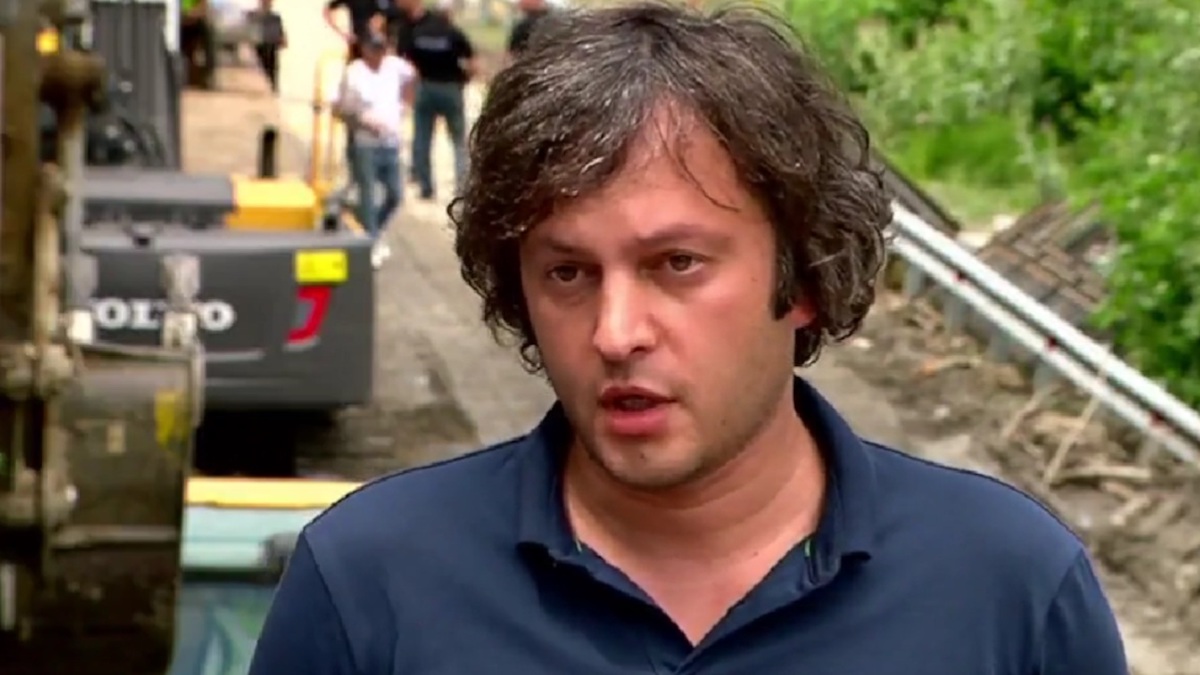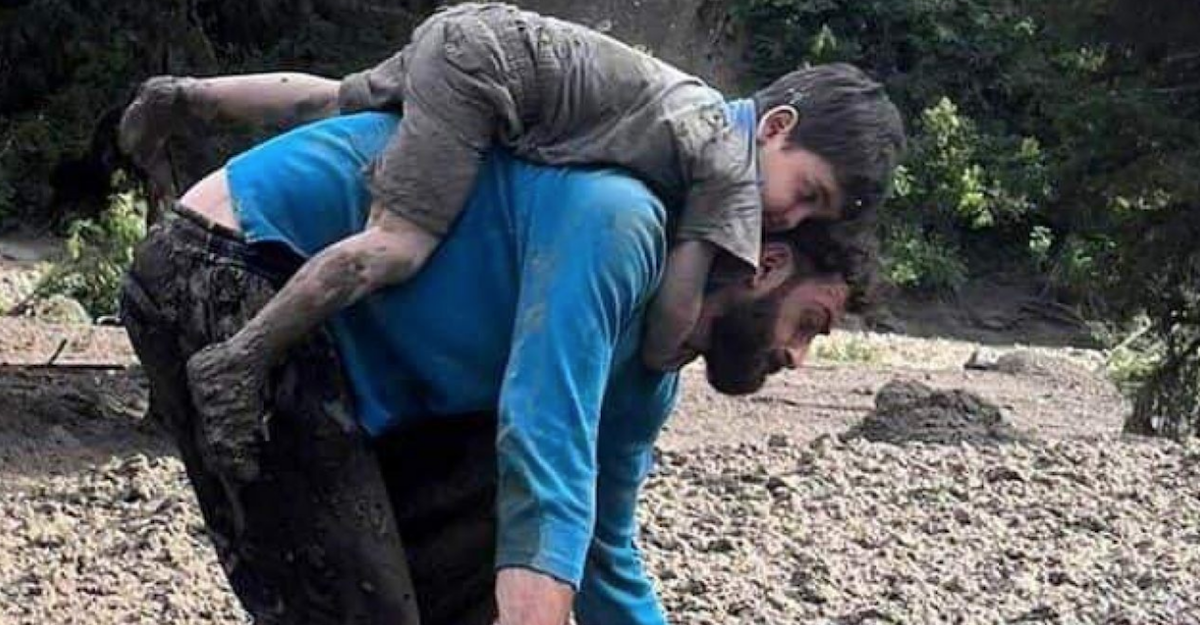Two weeks after the Shovi landslide. What do we know so far?
Landslide in Shovi
As of 10:00 on August 17, the bodies of 26 people were found in the disaster area in Shovi. There are children among them. Rescuers are still searching for the seven missing. There is no hope of finding them alive.

Now people have questions: what really happened? Has the glacier melted? Was the crash unexpected? Could this have been predicted a few days in advance? Could the victims have been avoided? To what extent were the rescue operations started correctly and in a timely manner?
In this article, JAMnews summarizes everything that is known about the tragedy in Shovi two weeks later.
On August 3, at 3 pm, a landslide hit the popular mountain resort of Shovi in Georgia. In a few minutes, the entire disaster area, including the cottages where people rested, was buried under several meters of landslide mud. The flooded river carried away bridges, cars, huge trees.
The victims called the emergency services. Rescuers soon arrived on the scene, but the scale of the disaster made it difficult for them to work. A rescue helicopter arrived at the scene in the evening, three hours after the incident, and evacuated 210 people from the disaster zone overnight.
So far, 27 bodies have been found. Rescuers are still looking for the six missing.
Landslide in Shovi
What is happening in Shovi now?
Rescue work, in which the military is involved along with the rescuers, went beyond the area where the landslide occurred. Bodies are already being searched in riverbeds within a radius of 50 kilometers.
The head of the rescue service said that 90 percent of the mass of mud masses brought by the landslide had been checked. From August 17, the main work will take place in the riverbed, with the connection of heavy equipment.
- Dozens dead and missing after landslide at mountain resort of Shovi in Georgia
- Tragedy in Shovi: What happened and could the loss of lives have been prevented?
Rescuers now and then discover household items and parts of human bodies. Some bodies are so mutilated that they can only be identified after DNA analysis.
Landslide in Shovi
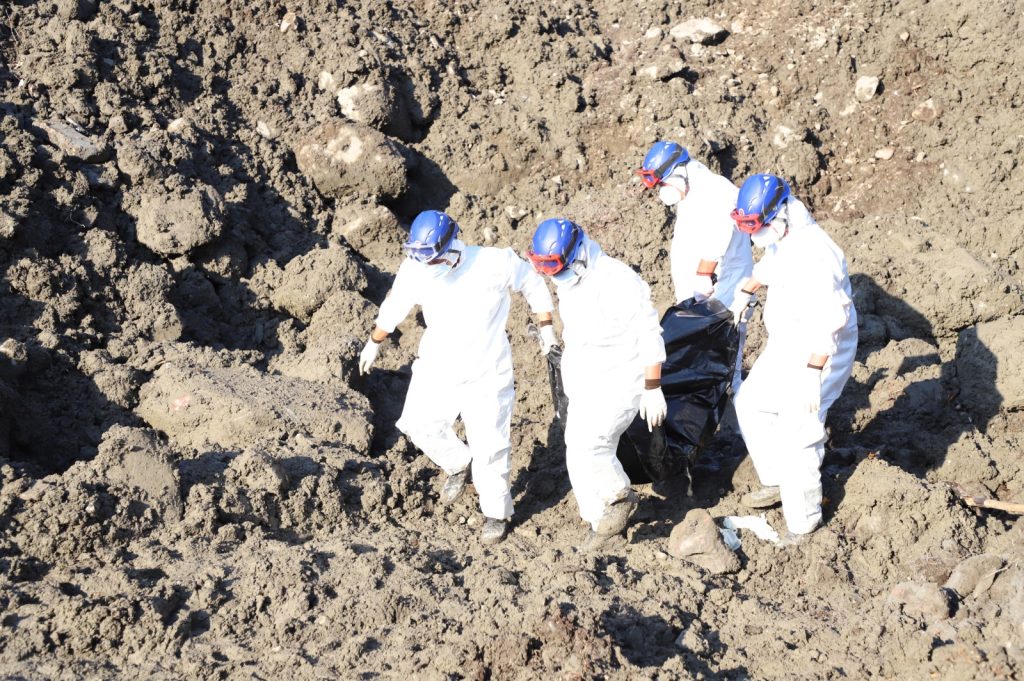
Rescuers work in the most difficult conditions. Photos appear on social networks, which show that they do not have specialized shoes and they attach thin boards to the soles.
Red Cross volunteers are also working in Shovi. All of them are warned that they need to be vaccinated against tetanus. But it is not known whether people are actually vaccinated. According to the Mtis Ambebi (Mountain News) publication, as of August 10, only 28 people received this vaccine. Despite the fact that tetanus is a life-threatening infection, it easily enters the human body through a wound or even a scratch on the skin, and in 40-50 percent of cases it is fatal.
Landslide in Shovi
Locals talk about the danger of the epidemic. Dead cattle are often found in the mud mass.
The wrecked cars found so far have already been taken away.
Shovi no longer exists. In Racha, the region where the resort was located, mourning has been declared. Several local residents who died in this tragedy have already been buried.
A police officer who died during rescue operations was also buried.
Mirian Chelidze, an investigator from the district investigation department, had a heart attack.
Everyone who visited the scene as a volunteer or in search of relatives writes that the situation there is much worse than the photos and videos convey.
Who are they looking for in the disaster area?
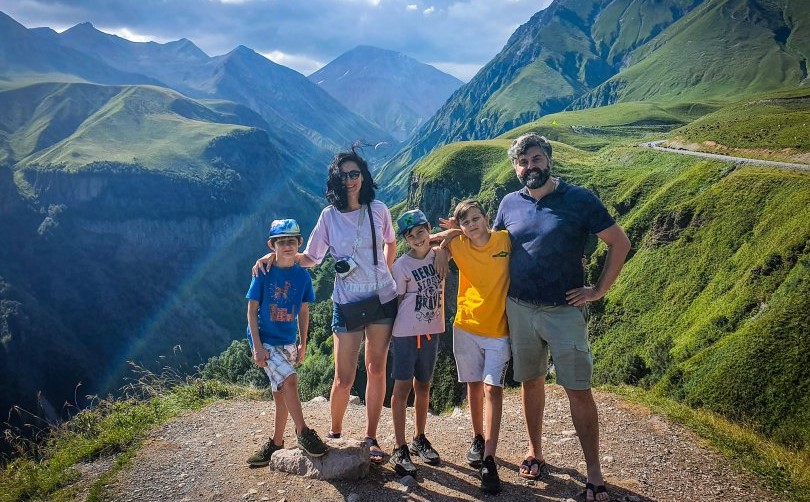
The official list of the dead and missing has not yet been made public. The media are looking for information about them in social networks.
Entire families and groups of friends are known to have died.
Most of the people who were in the cottages and near the mineral waters died. The landslide literally razed the cottages to the ground. Vacationers at the Sunset Shovi Hotel managed to survive the disaster, as the hotel is located on a hill and was not so badly damaged.
As of the morning of August 17, the following are still considered missing:
- 4-year-old Giorgi Khorbaladze – the boy was resting in Shovi with his mother and grandmother, whose bodies have already been found and identified;
- Gvantsa Bubashvili – Gvantsa was vacationing with her friends Nino and Salome. The girls went to Shovi in Gvantsa’s car. Gray “Hyundai” with the inscription “See you in Racha” was soon found by rescuers. There were no girls inside the car. A few days ago, the bodies of Nino and Salome were found;
- Andriy Dudashvili – Andriy was in Shovi with his mother, brother and sister. The father of the Giorgi family came to Racha in search of his wife and children;
- 24-year-old Kote Maisuradze was in Racha with his mother and sister. The women’s bodies are found;
- Nika Chaladze is a guy from the local village of Lagvanteli, who, together with his friends Dito and Temuri, built a cottage in Shovi. On August 3, the guys had their first working day. The bodies of Dito and Temur are found.
- Zaza Meskhi and his three children – Zaza Meskhi lived in the Netherlands with his Ukrainian wife and three children. The family came to Shovi to rest. The wife’s body has been found and identified, and Zazu and the children are still being searched for. One of the symbols of the tragedy was their happy family photo against the backdrop of the mountains in Racha.
Landslide in Shovi
What do we know about the dead?
The bodies of 27 people have been found so far. 24 of them have been identified.
JAMnews received data on 23 dead. Here are some of them:
- Giorgi Goginashvili, the body of a young man, father of two children, was one of the first to be found. Giorgi lived from Tbilisi, and in Shovi he stayed in a friend’s cottage. In social networks they write that he helped his wife climb a tree and went to save others. He saved and died himself already on the way back to the place where his wife was.
- Ksenia Tricheva, the body of a 31-year-old woman, a Russian citizen, was also found on the first day. A friend recognized her.
- Brother and sister Giorgi and Sopho Karalashvili and their friend David Beriashvili – Sopho and Giorgi were preparing to study abroad. Giorgi was going to study in Paris, while Sopho dreamed of studying in the USA. David has been working on a board game based on Georgian mythology and launched a crowdfunding campaign on July 23 to raise money to print the game.
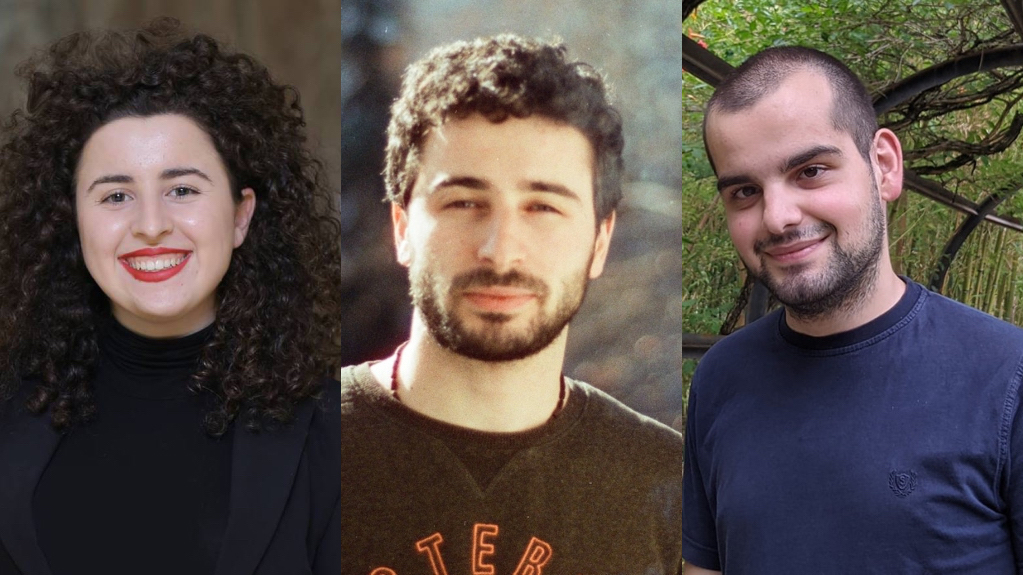
- Sopo Bakuradze was a 23-year-old single mother from the village of Glola. Every summer she worked as a maid in cottages in Shovi. Sophie is survived by a four-year-old child.
- Samira Issayeva – Samira, 18, arrived in Shovi on July 25 with her neighbors, the Khorbaladze family. The last time Samira’s family spoke to her was on 2 August. The girl’s body was identified by her father. Samira’s neighbors, Marina Khorbaladze, 60, and her daughter Manana also died. Manana’s 4-year-old son Giorgi Khorbaladze is one of those who are still missing.
- Genadi Sultanishvili, a resident of the nearby village of Glola, taught music at school and worked as a cook in the canteen at the cottages.
- Ketevan Lobzhanidze – vacationed in Shovi with her family. At the time of the natural disaster, the family was in the forest, and Ketevan and her husband stayed in the cottage. Ketevan’s husband survived.
- Six of the nine members of the Gutashvili family, including three children.

Landslide in Shovi
Who survived?
A rescue helicopter took 210 people out of the disaster zone. More than 20 of them (according to media reports) were trapped in several meters of landslide mud and fought for their lives for almost three hours. They were saved thanks to the locals.
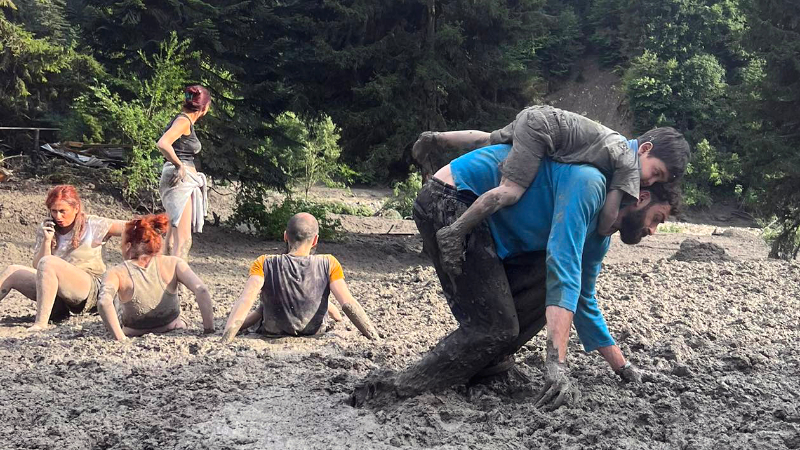
David and Masho – the story of the Geladze family
A long-haired girl, covered in mud, and a young man in a blue shirt, knee-deep in mud with a child on his back, are the first photos that circulated on social media shortly after the Shovi disaster. Both photos show members of the same family: an uncle and nieces.
A man with a child on his back – David Dzheladze. A large family of Geladze lives in the village of Uravi, Racha region. On this day, David, his mother, son-in-law, three sisters and nephews aged 11, six, four and three went to Shovi to rest.
It was good sunny weather. They took pictures, recorded TikTok, walked in the forest, drank the famous Shovi mineral water… The landslide overtook them when they were already preparing to go home.
David remembers that they managed to jump out of the cars and run off the bridge. Over the next few seconds, both of their cars were swept away by a powerful stream of mud. And ten family members were on different sides of this stream.
Waves of mud several meters high repeatedly hit the Geladze family, and one of the waves carried David and six-year-old Michaud away from the rest.
David and Michaud fought their way through the mud masses for several hours. When a man got stuck in the mud, he asked the boy to go himself, encouraging him and explaining what and how to do.
Michaud and his uncle had to walk several kilometers before they, covered in mud and covered in blood, could reach the relatively intact part of Shovi near the Sunset Shovi Hotel.
Already there they were helped by local residents. Michaud and David survived.
Other members of their family also survived. Local residents took them to a safe place, and then a rescue helicopter flew in.
Mariam, Shota and four-year-old Kotiko

Mariam Berianidze was hit by a landslide along with her husband and four-year-old son. They rested in one of the cottages.
“Sometimes I feel ashamed that we survived,” Mariam told a Radio Liberty journalist.
The woman says that she heard a terrible rumble, and then she saw a huge mass of dirt heading straight for the place where they were going to have a picnic.
Before her eyes, this mass carried away at least five people – a car with a young couple, a girl and a guy who were staying in the same cottage with them, and an elderly woman.
Landslide in Shovi
Mariam recalls that when she saw another wave of mud, she and her husband began to face each other.
“The husband took the child in his arms, stood with his back to the stream, and I hugged them in front. We were sure it was our end.”
For three hours Mariam, Shota and their son struggled with the elements.
“Whatever energy we had left, my husband and I used to cheer Kote up. We didn’t tell him, “We’re going to die.” We said: “You are a real spider-man!”, “How great you crawl!”. He had to overcome some sections in this stream on his own – none of us had the strength to carry him on his back, ”says Mariam.
By the time the rescuers showed up, they were already safe, thanks to the local guys who, to save them, laid paths from the boards from the cottages through the mud.
When Mariam got into the helicopter, she was all dirty and in her panties. She remembers the surprised face of the Minister of the Interior, who was in the helicopter.
“Do you know what it means to look into the eyes of death every second for three hours? Let them listen to the recordings of our calls to 112 [rescue service] as we scream. “Where is the helicopter?!”, and they answer us: “Your call has been accepted, the helicopter is taking off”, “Your call has been fixed, wait for an answer.” We didn’t just almost die there, we almost went crazy,” says Mariam.
Mariam and Shota, like the entire Geladze family, are still covered in bruises and cuts.
Landslide in Shovi
Father and son – Gio Adamia and six-year-old Tamaz

On August 2, Gio Adamia brought his six-year-old son Tomaz to the nearby village of Glola for the holidays. They were going to spend a week there and on the second day they went to Shovi.
They walked a lot. We drank mineral water. Toma rode on the swings at Sunset Shovi and Gio took pictures of him and sent them to his wife.
About three o’clock Gio and Toma decided to return home. They got into the car, and as soon as Gio began to start the engine, a terrible roar was heard.
At first he thought that a plane had flown over them. He got out of the car. It suddenly got colder. Looking towards the hotel, the man saw how huge trees were falling.
“I jumped into the car. Said to the child in the back seat, “Son, it’s a landslide, we need to hurry.” And we went.”
Two hundred meters later they met two tourists. On the road, a mass of mud was advancing behind them. They got into their car, and Gio tried to drive in the opposite direction. But the flow was already going from there. The car was trapped.
In addition to them, another 10-12 people ended up in the same trap. All cars swept away with mud in a few minutes.
Everyone rushed towards the hotel. He stood on a hill, and there were more chances to survive there. But as soon as they went uphill, a new stream came down from above. There was nowhere to run.
“There was a terrible panic, a scream. At that moment, I also thought that it was inevitable death. I hugged my son and stood facing the stream, ”Gio recalls in an interview with Radio Liberty.
When the wave rolled in, Gio lay on his back, pressed his son to his chest and let himself be carried by the current. After about 20 meters, he was able to stand up and continued on his way to the hotel.
“Even now I feel pain in my lower legs from sharp stones. With every step a new wound appeared. Everything around us was covered in dirt. It was terribly cold. The child was trembling. There was a tree there, I planted Tamaz on it and started calling 112 and our relatives.”
Gio and Tamaz, along with other people, were rescued by locals. They were taken out of the mud along paths made of trees and branches.
Later they were all taken by helicopter to Glola.
Gio says that if he had known about the impending stream at least two minutes earlier, he would have managed to avoid it.
Landslide in Shovi
What happened? What do we (not) know two weeks after the disaster?
Racha is one of the most seismically active and landslide-prone regions of the country.
But, as geologists say, there has never been a natural disaster of this magnitude in Western Georgia, except for the earthquake on April 29, 1991 in Racha, when one village was completely destroyed.
According to geologists, at this stage the risk of another landslide in the valley is minimal. However, this does not mean that there is no danger, because there are many glaciers in Racha.
More than two weeks after the tragedy, it is already known that the flood was caused by the flood of the river. The main question is where did so much water come from in the river? And there are several answers to this question.
Local residents, who are well acquainted with the glaciers and rivers of Racha, have a version that part of the mountain collapsed into the river, dammed it, and after a few hours this dam broke through.
The National Environment Agency rejects this version. The agency released its first report on the incident six days later, stating that the tragedy was caused by the coincidence of several geological and hydrometeorological events.
The agency writes that as a result of the collapse of the rock, a glacial massif of about 62 hectares was cut off, which caused the outflow of subglacial waters from the glacier, which rushed into the river valley.
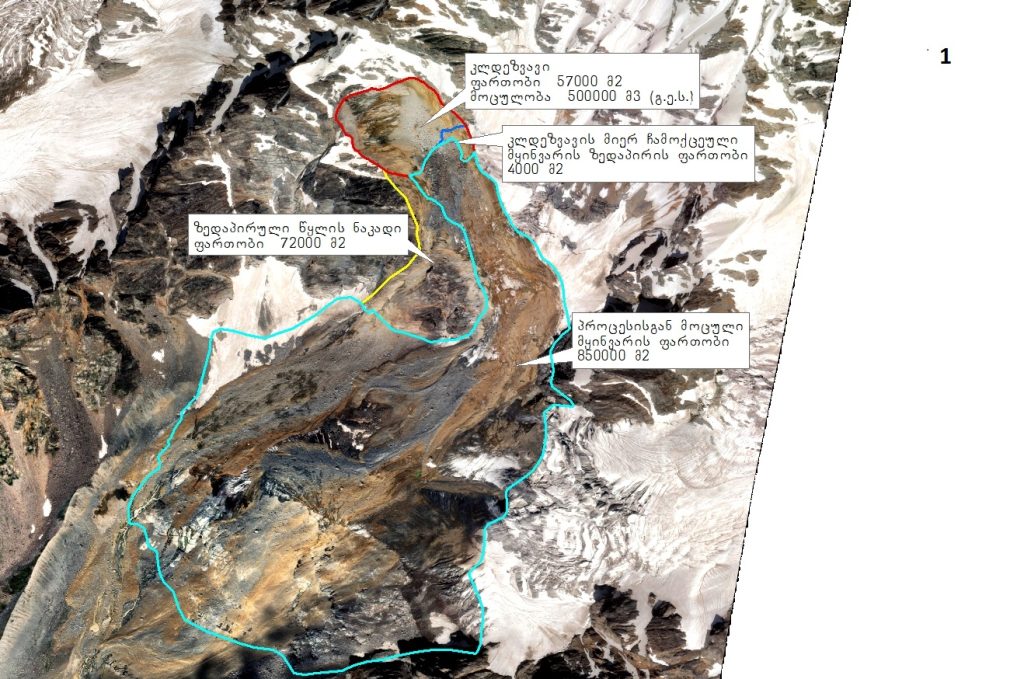
Landslide in Shovi
Lasha Sukhishvili, head of the geography department of the National Seismic Monitoring Center, describes the stages of the Shov disaster based on satellite photographs.
He writes that a large amount of water has accumulated in the epicenter of the disaster due to the melting of the glacier and rains, this water has activated the depleted rocks. As a result, on August 3, at about 2 pm, an array of rocks with an area of 57 hectares moved and reached the glacier in 20 seconds.
The impact of the avalanche on the glacier caused a glacial “lake” gap, imperceptible on the surface. All this mass moved towards the valley in two streams, carrying with it the upper thin layer of glaciers. After entering the river valley, the erosion of soil and depleted rocks began, and a landslide formed.
Nika Tsilaashvili, a hydrologist and associate professor at Ilia University, in an interview with Mountain News, says that the tearing off of a part of the rock could not have caused such a flood.
“A 62-hectare glacier cannot melt in five minutes. This is absurd. Water is what set it all in motion. The situation was already prepared there, it was shaky, it was just a push that brought everything together.”
Nika Tsilaashvili analyzes charts from the National Environment Agency, noticing suspicious changes in the water level in the river.
“For example, it is clear that in the period from 16 to 19 July, the water level in the river dropped. If the glaciers have melted due to rising temperatures, it has also rained, and the level of the river has not risen, there is already a suspicion that something has happened.”
Landslide in Shovi
Could the catastrophe have been foreseen and the victims prevented?
The catastrophe cannot be stopped, but it could have been foreseen and victims avoided – almost everyone agrees with this statement, except for the government.
Authorities say the crash was instantaneous and could not have been predicted.
According to the Ministry of Natural Resources, the flood reached the cottages in about 8-10 minutes. According to experts, this time would be enough to evacuate people to a safe place.

Lasha Sukhishvili lists for Radio Liberty three main factors on which people’s lives depend at such moments:
- early warning system [predicting a high probability of a catastrophe by various parameters];
- alarm system – receiving information about the process that has already begun in real time;
- informing people – how to act in a critical situation.
There was no monitoring system in Shovi in the disaster zone. At the moment, such systems exist in 18 regions of Georgia, and 11 of them were created in 2022-2023. Although five years ago, the Ministry of Environmental Protection stated that within two to three years, early warning systems would appear throughout Georgia.
Survivors recall that when they tried to get out of the mud mass, they heard the voices of people calling for help.
High-ranking officials even questioned the stories of the survivors, saying that it was generally impossible to travel long distances in such conditions and there was no need to cross from one side of the river to another at all.
The authorities launched an aggressive campaign against the survivors. For example, the chairman of the ruling Georgian Dream party, Irakli Kobakhidze, called the story of David Dzheladze a speculation.
The government is trying to completely evade responsibility – this is how sociologists assess their rhetoric. According to them, by refuting the stories of survivors, the authorities are trying to prove the impossibility of saving people trapped in a mud trap, no matter how and whenever rescue work is carried out. Because the delay in rescue work is one of the main accusations against the state.
On the day of the disaster, the rescue helicopter arrived in Racha three hours late. At that time, people stuck in the mud had already safely got out with the help of local residents. And at night, when dozens of people were considered missing, the helicopter stopped work. Because there is still no rescue helicopter with night vision equipment in Georgia. During such tragedies, the country uses two helicopters of the border service. The government has been promising for a decade that it will buy rescue helicopters.
At the same time, that night Georgia refused the help of neighboring countries.
“If there is no threat to life, then it is not advisable to take risks and fly at night,” Interior Minister Vakhtang Gomelauri said. Gomelauri, whose department is the main one in the fight against natural disasters, arrived in Racha only on the tenth day after the disaster. He explained this by saying that he was not in Georgia, as he accompanied his father to Turkey for treatment.
Landslide in Shovi
Will we find out what really happened in Shovi?
The opposition demands the creation of an investigative commission in the parliament to investigate the tragedy in Shovi. She is looking for an answer to two questions: could the tragedy have been avoided if there had been an early warning system, and how timely and effective was the reaction of state structures.
Meanwhile, in connection with what happened in Shovi, the Ministry of Internal Affairs opened two criminal cases: negligent murder (Article 116) and violation of safety regulations during mining, construction or other work (Article 240).
But lawyers believe that the Shovi disaster should be investigated under other articles, including endangerment (Article 128) and official negligence (Article 342).
Lawyer Ana Tavkhelidze says there is reason to believe the state may have abandoned people to their fate:
“They are constantly discussing how timely and correctly the assistance was provided… It remains to be seen whether the state left specific people without help,” Tavkhelidze told Radio Liberty.
In this case, we can even talk about double negligence: before the catastrophe, which someone could have prevented, but did not, and after the catastrophe, since it is not known whether the relevant department used all the resources to save people.
“Shovi is not only a disaster zone, but also a crime scene! That’s why the government didn’t want volunteers, journalists and international help. That’s why they started attacking the survivors! The criminal does not like witnesses, he is afraid of them!” Ana Tavkhelidze says.
Lawyers also talk about a conflict of interest during the investigation – the Ministry of the Interior would have to investigate its own department, about how quickly it reacted. And, even if the prosecutor’s office takes over this case, it is still difficult for lawyers to imagine that a full-fledged investigation will be carried out.
It is not yet known whether forensic experts are working in the disaster area.
Landslide in Shovi










